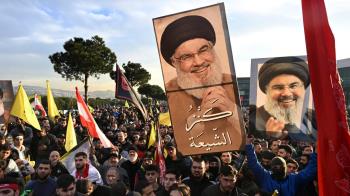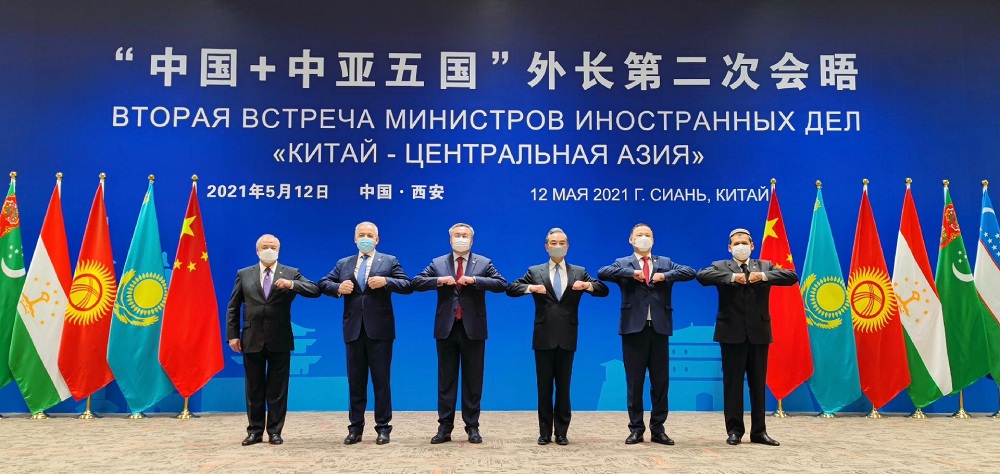Alwaght- In the past years, China held several meetings with Central Asian states to improve economic and political relations with them. This year, too, it gathered the leaders of this strategic region to bolster cooperation in the today's crisis-stricken world. The third summit of the Chinese foreign minister with counterparts from Central Asian countries was held on Wednesday in Nur-Sultan, the capital of Kazakhstan.
The meeting was attended by the foreign ministers of Kazakhstan, China, Turkmenistan, Kyrgyzstan, Tajikistan, and Uzbekistan. The two sides stressed the importance of further developing multilateral cooperation between the Central Asian states and China in terms of maintaining peace, stability and security, as well as sustainable socio-economic growth in the region. The FMs approved a roadmap for cooperation in security, transportation and logistics, energy, industry, climate change, green economy, technology, health, education, tourism, culture, and strategic issues.
China' FM Wang Yi announced that his country intends to boost multilateral cooperation with Central Asian countries. According to him, the summit agreed on joint efforts for the future, peace, and independence of Central Asia within the framework of good neighborliness, mutual interests, and mutual respect. The top foreign policy chief stressed that member states will ensure the functioning of the China-Europe route in a safe and stable manner. It was also stressed at the meeting that these countries are coordinating their positions on the situation in Afghanistan in order to contribute to stability in the country.
The China-Central Asia summit was established in 2020 as a Chinese initiative, and the Nursultan summit is its third. The purpose of these annual meetings is to develop regional cooperation. The previous two were hosted by China, and all members agreed to develop economic and trade relations, and the results are clearly visible as the statistics of annual trade between China and Central Asia show significant growth in the past two years.
Although none of the members of the summit have yet recognized the Taliban government, they all have good relations with the once-rebel group. All participants at the meeting have already expressed concern about the activities of terrorist groups in Afghanistan. As Beijing and Central Asia are concerned about the threat posed by terrorism in Afghanistan and its spread in the region, they are working to counter the dangers through a regional security mechanism. They know that the spread of Afghanistan insecurity to these countries in the present situation will foist heavy costs on them and therefore they are trying to bring back stability to Afghanistan. China has repeatedly hosted delegations from the Afghan government and the Taliban, and has shown how important security in Afghanistan is to it.
To demonstrate how important Central Asia and China are to each other, the Chinese FM said at the annual meeting that the two are "close like teeth and lips, share joy and sorrow, and shoulder to shoulder move forward like a community with a common fate." Such remarks indicate the strategic position of Central Asia for Beijing leaders. The meeting also approved by consensus four documents under "joint declaration of the third China-Central Asia foreign ministers meeting," the virtual meeting roadmap, the initiative for deepening cooperation among the members, and the initiative for cooperation in cyber security.
Central Asia's role in China-Europe corridor
China has already solidified its foothold in Central Asia through economic and political relations, but the region's importance for Beijing grew larger in recent years and specifically after the Russian operation in Ukraine. China used to transfer its goods to Europe via Russia. However, after the war, the European states closed down their borders to Russia, leaving China struggling with the consequences.
The Russian railways, which played a major role in the transportation of goods between China and Europe, are now subject to US and European sanctions, and it is practically impossible for China to use Russia's transit routes. Therefore, Beijing is looking for alternative corridors, the best and most economical of which is Central Asia. China's proximity to Central Asia allows it to transport goods through the region's transit routes to Europe. In the past three months, it has transferred a large part of its goods from Central Asian countries to Turkey and from there to European countries, and land transportation routes in Central Asia have become particularly important in the Chinese-European trade.
With China convinced that Western sanctions against Russia will be kept for a long time, it is moving away from the Russian routes and seeking to strengthen Central Asia's transit corridors so that it can send its goods as soon as possible to European markets. Following the eruption of Ukraine crisis, Central Asia's position in the development of global transport has improved. Estimates by an association of large state-owned transport companies in the region suggest that goods transported through Central Asia and the Caucasus by end of 2022 will increase six folds to 3.2 million tons compared to the year before, largely due to Chinese exports through these routes. However, China, which expects using Central Asian routes for a long time, pushes to improve its relations with governments in the region, holding annual ministerial meetings and even leaders-level summits with the regional countries.
Central Asia, on the other hand, plays an important role in China's Road and Belt initiative, and is involved in this global project, as the Chinese strategists view Central Asia as the main route to bring back to life the ancient Silk Road. At last year's meeting of the Chinese and Central Asian ministers, all members agreed on a pilot implementation of the Road and Belt project. Therefore, the transfer of Chinese goods via railways and transit from Central Asia to Europe could be a test for China's new Silk Road and, if successful, could be formalized in the future.
To achieve its goals, China assisted economically-weak countries in the region, and in recent years invested heavily in their transportation and economic infrastructures. Its trade with Central Asia has also grown significantly annually, with an estimated $45 billion in 2021, up 10 percent from the previous year. This figure could set a new record in 2022 due to the Ukraine crisis and China's use of Central Asian corridors. China has also developed its security and economic relations with Central Asia through the Shanghai Cooperation Organization (SCO), and because of its role in world political and economic developments, Central Asian leaders have embraced Beijing in their economies.
The huge energy resources in Kazakhstan and Turkmenistan are very important to China, and in recent years Beijing received part of its oil and gas from these countries. China has always emphasized peace and stability in Central Asia since in a state of security it can pursue its megaproject to revitalize the Silk Road. One of the reasons why this plan has not been implemented so far is the insecurity in Afghanistan, and if security prevails in the region, with the participation of member countries in this plan, the Silk Road will soon bear fruit, as many transportation infrastructures has been provided in Central Asia as well as Iran.
The US competition with China
Rivals in many areas around the world in the past decade, China and the US care to be present in the strategic parts of the world. Central Asia is one of these parts. In recent years, Central Asia has become particularly important to the Americans for its proximity to the Russian and Chinese borders. Washington is trying to build pressure on China and Russia as its two main rivals by bringing pro-Western governments to power in Central Asia and therefore adding them to the Western camp.
Although Washington has failed to achieve its goals over the past two decades because of Russian sensitivity and China's positive role in the region, the Americans will highly likely pursue their doomed plans seriously after the Ukraine war. Recently, a delegation of senior US political and security officials traveled to Uzbekistan, Kazakhstan, Kyrgyzstan, and Tajikistan to shore up their relations with those countries. Although US officials' visit to Central Asia is aimed at striking at Russia, countering Chinese influence is also one of Washington's main goals. Therefore, with a strong presence in Central Asia, the Americans are trying not only to reduce Russia's influence in the region but also to closely monitor China's activities and steps.
The Americans know well that if China, Russia, and Iran unite, they can shake the already waning US hegemony. So, by cozying up to the Central Asian states, they try to undermine the in-the-making powerful triangle against them. Central Asia is the juncture where this alliance can be hit, the Americans think.
Given the recent American-Chinese tensions over Taiwan, the American officials are trying to move closer to China's borders and, as they think, tighten the noose on the rival. Knowing that China chose Central Asian transportation corridors as alternatives to Russia's after Ukraine war, the US strives to distance West Asia from Beijing and raise its costs. The Americans are well aware of growing weight and influence of China in the region and increasing pressures on Central Asia to review their contacts with it bears witness to this reality.
Performing successfully in its competition with the US in the past decade, China– especially after Ukraine crisis that pushed the tensions with Washington to a turning point– intends to bring its Central Asian allies to its camp. Regional summits and cooperation toward realization of new Silk Road ambitions, in case of success, are what can heighten China's global position and shatter the declining US hegemony after several decades.



























